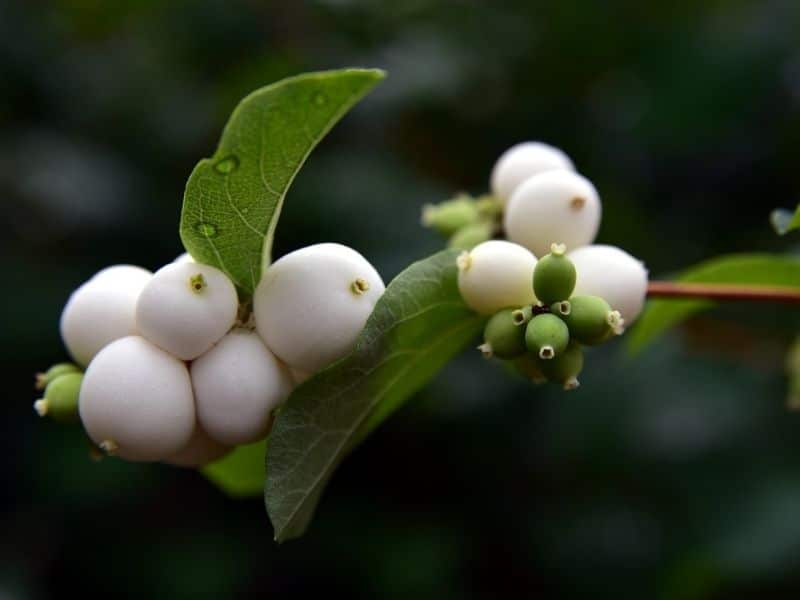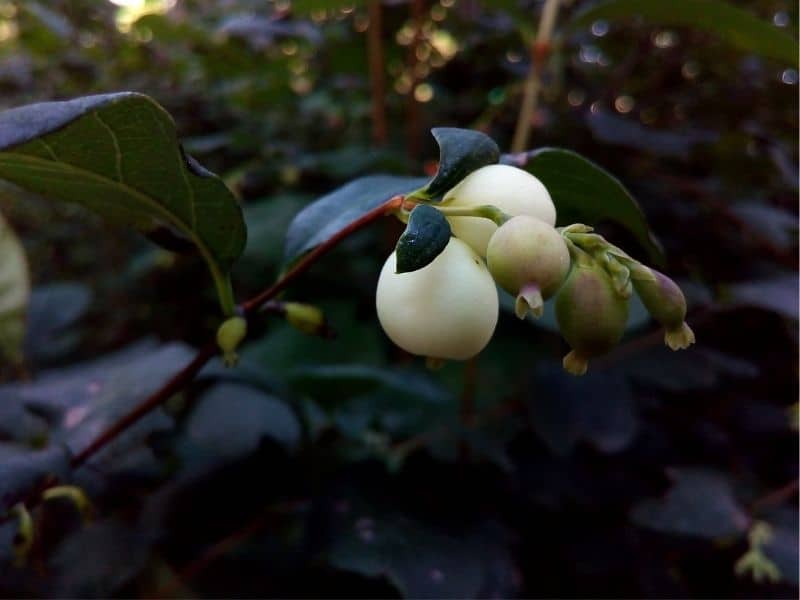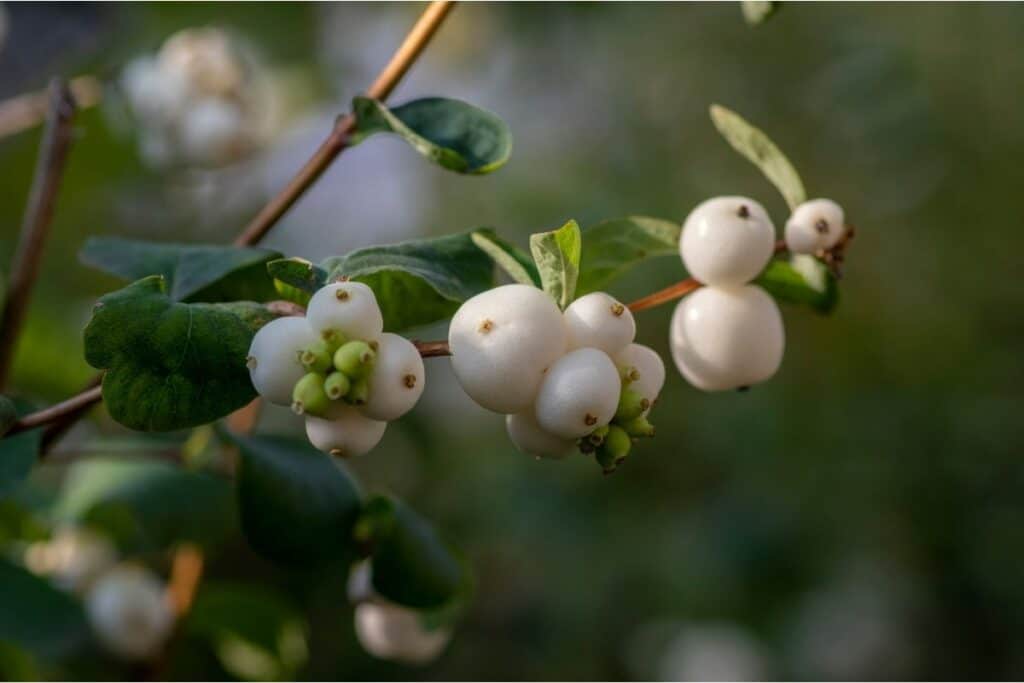The Snowberry is a native deciduous shrub that provides winter interest and needs very little attention. If you’re looking for a new shrub for your naturalized or native garden, this might be a great plant for you. Read on to learn more about how to care for and grow the snowberry plant.
What Is A Snowberry Bush?
The snowberry is a native deciduous shrub from the honeysuckle family. These plants are also known as the common snowberry, waxberry, ice apple, or white coralberry, and their scientific name is Symphoricarpos albus.
These upright or arching shrubs take on a rounded form and grow to about 6ft (1.8m) tall and equally wide. Most snowberry bushes will usually only grow to about half that size, however.
These plants can be found in valleys and swampy thickets across Canada and the northern USA, south through Wyoming and Colorado through to New Mexico and Arizona. These native plants can also be found on the west coast reaching as far south as southern California.
The dull to blue-green leaves grow up to around 2 inches (5cm) in length and are arranged oppositely on branches.

Snowberry Flowers
The snowberry shrub produces unimpressive, ¼ inch long white to pink flowers that bloom from June to August. (1) These flowers are known to excite pollinators more than they do people and the most attractive feature of these plants is certainly their fruits.
The profusion of pure white berries produced by the snowberry bush is where the plants take their name from. These berries measure up to ½ inch (13mm) across and ripen from the end of summer to fall, lasting deep into the winter months.
Snowberry Varieties
A few varieties have been developed to have a denser and more compact growth form, as well as increased berry production. These include:
- ‘Bright Fantasy’ reaches about 4ft tall and produces larger, snow-white berries.
- ‘Charming Fantasy’ reaches about 4ft tall and produces larger, pink-tinged berries.
- ‘Scarlet Pearl’ reaches about 4ft tall and produces larger, pink berries.

How To Grow A Snowberry Shrub
It is possible to collect and grow your own seeds but this can be quite a time-consuming method of propagation.
The seeds of these bare root plants can be collected in late August and should be removed from mashed fruits, cleaned, and allowed to dry. The seeds will then need to be kept warm for around 3 months and then cold for about 4 months before becoming fertile.
A faster and easier way to propagate these plants is by 2-3 inch (5-7.5cm) long soft or semi-hardwood cuttings taken in early spring to early autumn or from hardwood cuttings taken in winter. (1)
These snowberry shrubs will grow in various soil types, including sandy and rocky soils. Good soils for this plant can range from slightly acidic to slightly alkaline in nature.
Keep the soil moist for your snowberry tree regularly until it is established, and the plants can then be left to grow naturally since they are quite a drought-resistant species. Regular watering may improve the health and appearance of your plant, and giving your plants some additional water in very hot or dry periods is a good idea.
This versatile plant can be grown in full shade, however, if you really want the snowberries to thrive, plant it in a partial or full sun location where it will produce more fruit.
Snowberry plants do well in cool environments and can be grown in USDA hardiness Zones 3 to 7.
Care and Maintenance
The snowberries are a very low maintenance, easy to grow bush. These plants need very little from you and will quite happily grow without any attention at all in the right environments.
If you want to regrow a thin-looking snowberry bush, you can cut this plant right back to the ground to encourage a denser, bushier growth form. For general tidying up, prune this plant down to about 1ft (0.3m), and remove any untidy or dead growth. (2)
These plants are generally pretty pest and disease resistant but as with most shrubs, see to it that the plant is not overwatered or kept in saturated and poorly drained soil.
Snowberry plants may, however, be affected by a fungal disease known as anthracnose, and by pests such as aphids, scale, and certain moths. (3) Additionally, keep an eye out for signs of powdery mildew, which appears as a pale white, powdery coating on leaves and can lead to yellowing leaves and eventual plant death.
Uses
Horticultural Uses
Snowberry is a great plant for native wildlife gardens where they can be left to grow naturally in a nature garden. These plants could also be used in an attractive mixed border. Due to their tendency to spread by suckering, they make a good choice for mass planting on recovering banks and eroded areas.
Human Uses
Unfortunately, these plants are not edible but they do have a number of traditional uses, including the medical treatment of sore eyes and teeth, skin rashes, and as a diuretic and laxative.
Wildlife Uses
Pollinators like hummingbirds and butterflies will often visit the flowers on these plants with white berries. Their fruits are eaten by a variety of birds and mammals, although they are not favored and tend to stay untouched for long periods. The foliage is browsed by white-tailed deer, elk, and moose.
FAQs
How fast does snowberry grow?
Snowberry (Symphoricarpos spp.) is a relatively fast-growing shrub, typically reaching its mature size within a few years under optimal growing conditions.
How long does it take for Snowberries to grow?
Snowberries can take several years to reach their full size and produce berries. However, they may start flowering and fruiting within 2-3 years after planting.
How deep are snowberry roots?
Snowberry roots are shallow, typically extending to a depth of 12-18 inches in the soil. However, they can spread widely, especially in favorable conditions.
Can you eat snowberries raw?
No, Snowberries are toxic to humans if ingested in large quantities and can cause gastrointestinal distress. While some birds and wildlife may eat snowberries, they are generally considered unpalatable and not recommended for human consumption.
How do you stop snowberry from spreading?
To control the spread of snowberry, consider planting it in containers or using barriers such as root barriers or underground barriers to limit root expansion. Regular pruning and removal of suckers can also help prevent excessive spreading. Additionally, keep the area around snowberry plants well-mulched to discourage the growth of new shoots from fallen berries.
Conclusion
If you’re looking for a specimen plant, the snowberry is probably not the plant for you. That being said, these plants do put on an attractive display with their snow-white berries. These plants need very little care and are one of the few good options for native winter interest plants that can be grown in colder climates.
Up next: How to Grow and Care for Coralberry (Symphoricarpos orbiculatus)
References
References
(1) Toogood, A. Plant Propagation: The Fully Illustrated Plant By Plant Manual Of Practical Techniques.
(2) Brickell, C. & Joyce, D. Pruning & Training: What, When And How To Prune.
(3) The Connecticut Agricultural Research Station. Snowberry (Symphoricarpos) Plant Health Problems https://portal.ct.gov/CAES/Plant-Pest-Handbook/pphS/Snowberry-Symphoricarpos
Close
*Featured image by ivusakzkrabice/depositphotos







